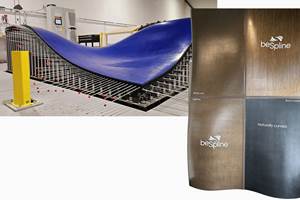The first fully-infused boat hull in India a success
DIAB's Composites Consulting Group (CCG) assists Aquarius Fibreglas in designing the infusion of a 15.6m fast interceptor craft.
Aquarius Fibreglas, located in Goa, India, is the first Indian boat manufacturer to develop a fully infused vessel. Featuring a DIAB Group (Laholm, Sweden) sandwich core, the vessel is a 15.65m Fast Interceptor Boat. Composites Consulting Group (CCG, Laholm, Sweden), an independent DIAB Group company, offered Aquarius a full onsite build to ensure the full value of composite design was realized.
The marine industry in India has traditionally been dominated by steel and alloy constructions. But there are exceptions. Aquarius Fibreglas, founded in 1995 by Ratnakar Dandekar, prefers building boats in advanced composites. Aquarius started out by working in partnership with well-established naval architects outside of India. However, it didn't take long before this ambitious shipyard moved on to making its own designs and constructions. Dandekar was well aware of the resin infusion process and its benefits for advanced marine composite builds, but to introduce resin infusion to his shipyard, he contacted CCG, who he knew had extensive experience in this field. After some initial discussions with Rimzath Ali from CCG , Aquarius decided to try the process of vacuum infusion for an 8m cruise boat. Dandekar hoped that this would prove that boats built with vacuum infusion technology could be a reality in India.
In the third quarter of 2014, Aquarius shipyard won a contract to design and build a series of 15.65m Fast Interceptor Boats with top speeds of 35 knots and meeting DNV GL standards. The boats would be built in India and delivered overseas for coastal patrol and interception work. Again, Aquarius contacted CCG for help with designing the structural engineering of the vessel in order to meet the GL-required classification. This was a key area as CCG also had the knowledge of how to engineer the vessel to guarantee a successful infusion process.
The core materials were delivered in early January 2015 and the building process itself started on January 23. Over a period of two weeks the staff at Aquarius, under the guidance of CCG, set up and successfully infused the hull, followed by the deck and bulkheads. The new technique meant that no plywood was used in the building process. All areas requiring bolting or fixings used high-density DIAB core instead. The core is about half the weight of plywood but offers the same or better compressive strength and has great screw retention qualities.
“This was a difficult first build as the entire hull was infused in one piece," said Todd Henry, Asia Region manager at CCG. “The staff was extremely careful with the accuracy of the core fitting and the placement and overlapping of the fibers, ensuring the structural design was carried out exactly as the plan dictated. This is never easy and yet I went away very satisfied with the task completed and knowing Aquarius is ready to continue on its own.”
Aquarius Fibreglas is now preparing to build the remaining 10 boats and CCG will continue to offer support when and where needed. CCG's Ali commented, “We hope that the efforts taken here by Aquarius will encourage others in the marine market in India to use this technology and show that we can build as good a product as anyone else.
Read more about Aquarius Fibreglas:
Related Content
MiniLab consortium produces first full-scale thermoplastic composite hydrofoils
Project advances toward first recyclable foils for ocean racing, part of “Infinite Foil” finalist for JEC Innovation Award 2025.
Read MoreEvolving natural fiber technology to meet industry sustainability needs
From flax fiber composite boats to RV exterior panels to a circularity model with partnerships in various end markets, Greenboats strives toward its biomaterials and sustainable composites vision in an ever-changing market.
Read MoreCEAD launches the Maritime Application Center dedicated to industrial 3D printing boat hulls
The MAC is an LFAM-powered production facility equipped with highly automated, digitally driven manufacturing processes and built around a collaborative model to develop the boats of the future.
Read MorePlant tour: BeSpline/Addcomp, Sherbrooke, QC, Canada
Composites automation specialist increases access to next-gen technologies, including novel AFP systems and unique 3D parts using adaptive molds.
Read MoreRead Next
All-recycled, needle-punched nonwoven CFRP slashes carbon footprint of Formula 2 seat
Dallara and Tenowo collaborate to produce a race-ready Formula 2 seat using recycled carbon fiber, reducing CO2 emissions by 97.5% compared to virgin materials.
Read More“Structured air” TPS safeguards composite structures
Powered by an 85% air/15% pure polyimide aerogel, Blueshift’s novel material system protects structures during transient thermal events from -200°C to beyond 2400°C for rockets, battery boxes and more.
Read MoreComposites end markets: New space (2025)
Composite materials — with their unmatched strength-to-weight ratio, durability in extreme environments and design versatility — are at the heart of innovations in satellites, propulsion systems and lunar exploration vehicles, propelling the space economy toward a $1.8 trillion future.
Read More











